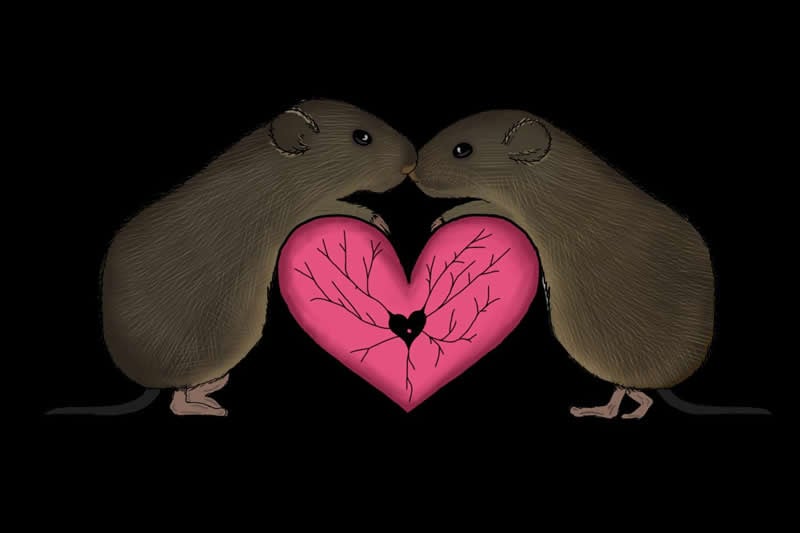Summary: Neuroimaging study reveals the neural basis for the motivation to reunite with the ones you love. The findings could lead to new therapies for disorders associated with social behaviors, and may also help explain why social distancing is so tough.
Source: University of Colorado at Boulder
When it comes to forming a lasting bond, our longing for a partner may be as important as–if not more important than–how we react when we’re with them, suggests a surprising new brain imaging study published in the Proceedings of the National Academy of Sciences this week.
“In order to maintain relationships over time, there has to be some motivation to be with that person when you are away from them,” said lead author Zoe Donaldson, an assistant professor of behavioral neuroscience at the University of Colorado Boulder. “Ours is the first paper to pinpoint the potential neural basis for that motivation to reunite.”
The paper marks the latest discovery in Donaldson’s years-long study of prairie voles, one of only about 3% to 5% of mammalian species (including humans) that tend to mate for life. By observing the behavior and brain activity of the monogamous rodents, she seeks to better understand what brain regions–down to the cellular level–drive the instinct to form lasting bonds.
Ultimately, the findings could be used to develop therapies for those with autism, severe depression and other disorders that make such emotional connections hard to come by. But right now, she said, the research also lends insight into why social distancing is so tough.
“We are uniquely hardwired to seek out close relationships as a source of comfort, and that often comes through physical acts of touch,” she said.
For the study, Donaldson used tiny cameras and a cutting-edge technology called in-vivo-calcium imaging to spy on the brains of dozens of voles at three time points: when they were just meeting another vole; three days after they had mated; and 20 days after they had essentially moved in together. Researchers also observed the animals interacting with voles who were not their mates.
Previous brain imaging research in humans has shown altered brain activity in a region called the nucleus accumbens, the same reward center that lights up during heroin or cocaine use, when the research subjects held the hand of a romantic partner versus a stranger. So, at first, Donaldson’s team assumed the voles’ brain activity would be markedly different when they were huddling with their mate versus a random vole.
“Surprisingly, that is not what we found,” she said.
Stranger or lover, the voles’ brains looked basically the same when they were together.

It was only when the voles were away from their partner and running to meet them–imagine the classic romantic reunion-scene at the airport or the theme of any number of love poems–that a unique cluster of cells in the nucleus accumbens consistently fired up.
The longer the animals had been paired, the closer their bond became and the larger the glowing cluster of cells–dubbed the “partner approach ensemble”–on image screens.
Notably, a completely different cluster of cells lit up when the vole approached a stranger.
“This suggests that maybe the recruitment of these cells for this new purpose is important for forming and maintaining a bond,” Donaldson said.
She suspects that brain chemicals like oxytocin, dopamine and vasopressin, which have been shown in both animal and human studies to play a role in fostering trust and closeness, are involved in the process. But she doesn’t know for sure what that cluster of cells does.
It’s also not clear whether the specific “neuronal code” associated with a desire to reunite in voles inspires the same emotion in people. More research is underway.
What the study does confirm is that monogamous mammals are uniquely hard-wired to be with others.
“These negative feelings so many of us are experiencing right now may result from a mismatch: we have a neuronal signal telling us that being with loved ones will make us feel better, while practical restrictions mean this need is going unmet,” Donaldson said. “It’s the emotional equivalent of not eating when we are hungry, except now instead of skipping a meal, we are slowly starving.”
About this neuroscience research article
Source:
University of Colorado at Boulder
Media Contacts:
Lisa Marshall – University of Colorado at Boulder
Image Source:
The image is credited to Zoe Donaldson.
Original Research: Closed access
“A neuronal signature for monogamous reunion”. by Zoe Donaldson et al.
PNAS doi:10.1073/pnas.1917287117
Abstract
A neuronal signature for monogamous reunion
Pair-bond formation depends vitally on neuromodulatory signaling within the nucleus accumbens, but the neuronal dynamics underlying this behavior remain unclear. Using 1-photon in vivo Ca2+ imaging in monogamous prairie voles, we found that pair bonding does not elicit differences in overall nucleus accumbens Ca2+ activity. Instead, we identified distinct ensembles of neurons in this region that are recruited during approach to either a partner or a novel vole. The partner-approach neuronal ensemble increased in size following bond formation, and differences in the size of approach ensembles for partner and novel voles predict bond strength. In contrast, neurons comprising departure ensembles do not change over time and are not correlated with bond strength, indicating that ensemble plasticity is specific to partner approach. Furthermore, the neurons comprising partner and novel-approach ensembles are nonoverlapping while departure ensembles are more overlapping than chance, which may reflect another key feature of approach ensembles. We posit that the features of the partner-approach ensemble and its expansion upon bond formation potentially make it a key neuronal substrate associated with bond formation and maturation.
Feel Free To Share This Neuroscience News.







